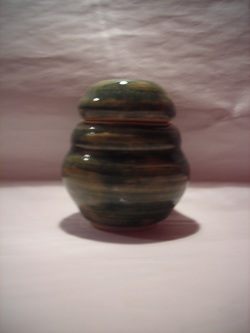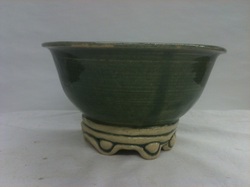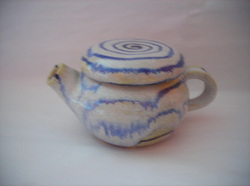
Some artists use form to show off light as opposed to using glaze. This is a 13cm by 7.5cm lidded project. The project has three bumps on it, one of them coming from the lid. From the base up, the bumps become smaller in circumference. The bumps make the project look wider than it actually is. The whole project was dipped in mystery. The indent between bumps reflects light well, as seen in the picture, giving off a new sense of light, rather than just being shown through the glaze.

Some artists use glazes to bring together separate parts of a project. This is a 16cm by 8.5cm hand and wheel bowl. The bowl was thrown on the wheel. Then, rather than footing it, it was rounded on the bottom and various types of coils were added. The bowl has a slightly flared lip. The coils are a square shape. The bowl and the cracks between the coils are glazed in mystery. The rest of the coils are clear. Although the two halves of the project are different, the glaze unifies all the pieces.

Some projects use glazes to show the technical side of ceramics rather than emphasizing the artistic side as most do. This is a 9cm by 18cm teapot. It is short with small features. Both the handle and the spout are little. When the teapot is picked up, one can feel how heavy it is. The teapot was first dipped in sand on the inside and out. On top of the sand glaze, the teapot is painted with a cobalt blue stain in a spiral. The spiral starts in the center of the lid and circles around the teapot to the bottom. In the kiln, the glaze and stain were pulled down and it is visible in the stain. This illustrates how physics and gravity are present in the project. The dripping creates a sense of movement in the teapot.



 RSS Feed
RSS Feed